Gunja – Abrus precatorius uses, purification, side effects, Remedies
Gunja – Abrus precatorius, belongs to the family leguminosae (Simbi kula) is a poisonous herb used in Ayurvedic medicines after the detoxifying process. Its seeds and roots are used in treating hair fall, arthritis pain, as an aphrodisiac and more.
Table of Contents
Types
There are two types mentioned –
Sweta Gunjia – White variety
Rajta Gunja – Red variety
Medicinal qualities
Indian Licorice medicinal qualities:
Rasa (taste) – Tikta – bitter, Kashaya- astringent
Guna- Laghu, Ruksa
Vipaka- Katu – Undergoes pungent taste conversion after digestion
Veerya – Ushna – Hot potency
Effect on Tridosha – Balances Kapha and Vata Dosha
Pharmacological action – Analgesic, abortifacient, Antispasmodic, CNS depressant
The plants are denoted in three varieties by their seed colors namely white, black and red.
The seeds undergo pungent kind of bio transformation and hot potency. The seeds subside both Kapha and Vata Dosha; the seeds pacify all the three doshas.
Part used, dosage
Part used- Root, leaf, seed
Dosage- Root& leaf powder 1-3 g , seed powder – half to one and half Gunja – 60-180 mg in divided doses per day.
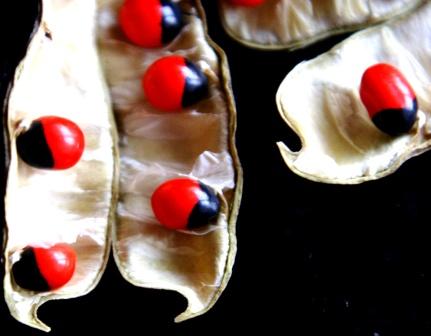
Uses
Abrus precatorius uses:
Both red and white varieties of Gunja are attributed with below qualities:
Kamoddeepana – Aphrodisiac, increases sexual strength
Shukrajanana – promotes sperm production
Ruchya – improves taste, useful in anorexia
Vishahara – anti toxic
Vrushya – aphrodisiac
Vranahara – speeds up wound healing
Chakshushya – useful in improving eye sight
Keshya – improves quality of hair
Tvachya – improves skin quality, useful in skin diseases
Ruchya – improves taste, useful in anorexia
Balaprada – improves strength and immunity
Indications
Indicated in:
Urusthambha – thigh stiffness
Amavata – Rheumatoid arthritis
Kasa – cold, cough
Indralupta – alopecia areata
Graharoga – psychological disorders
Kandu – itching
Kushta – skin diseases
Vrana – ulcers, wounds
Krumi – worm infestation (in wounds and in intestines)
Shosha – emaciation, loss of tissue
Bhrama – dizziness
Shwasa – asthma, respiratory disorders involving difficulty in breathing
Trushna – Excessive thirst
Mada – intoxication
Gunjamoola – root
Shoolaghna – relieves abdominal colic
Vishahara – anti toxic
External application
Purified Gunja seed powder is made paste with water, applied externally to relieve joint pains, swelling, sciatica pain, cervical spondylosis related pain.
This paste is applied over hairless patches of alopecia areata to regrow hair.
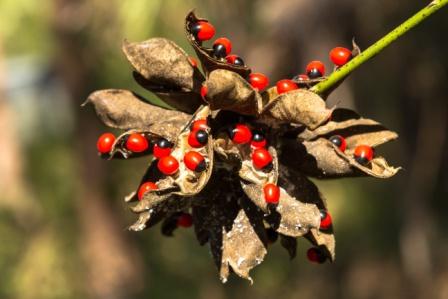
Chemical constituents
Abrus precatorius chemical constituents:
Root- Precol, Abrol and two alkaloids(abrasine&precasine), abrasine, precasine and precol, protein, abraline, abricin, abrusgenic-acid, abrusgenic-acid-methyl-ester, abruslactone, abrussic-acid, anthocyanins, calcium.
The roots contain precol, abrol, abrasine, precasine, cycloartenol, carpesterol, stigmasterol etc.
Seeds- Abrine, Hypaphorine, Trigonelline, Precatorine, Abridin, amino acids like serine, Abrusin, Abrusin-2-0-apioside, hederagenin, kaikasaponin III, sophoradiol, sophoradiol-22-0-acetate, tryptophan,
poisonous protein, a fat-splitting enzyme, aglucoside abrussic acid, haemagglutinin, albuminous substance named abrin.
The seeds are reported to contain abrine, hypaphorine, choline, trigonelline, precatorine etc. The scientists have isolated two anti cancerous principles from the seeds namely the Abrin A and Abrin B.
Leaves – abrine, trigonelline, abruslactone A, hemiphloin, abrusoside A, B, C and D, xylose, choline, hypaphorine, precatorine, glycyrrhizin
Sanskrit verse
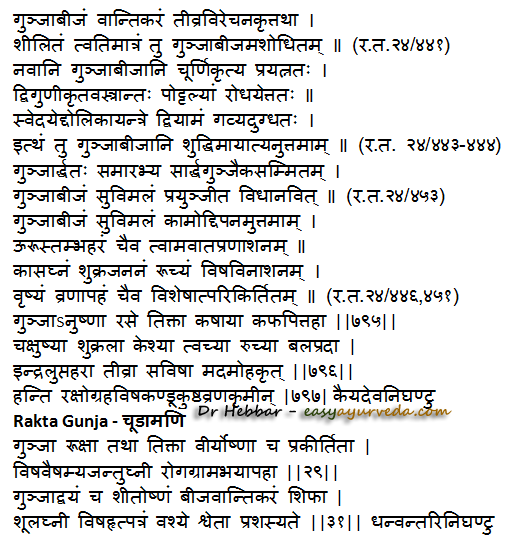
Adverse effects
Adverse effects of abrus seeds:
Gunja seeds if used without proper purification or in higher doses may cause –
Vantikara – vomiting
Teevra Virechanakrut – severe purgation
Fatal dose – 1 – 2 seeds
Fatal period – Minimum 24 hours
Poisonous effects
Painful swelling and ecchymosis
Necrosis
Nausea and vomiting
Abdominal pain and diarrhoea
Purification method Gunja Shodhana
Gunja Shodhana – Purification method:
The Gunja seeds are tied in a two layered cloth, kept suspended in cows milk taken in a pot. The milk is then boiled with the Gunja seed pack suspended for 1 Yama – 3 hours. This procedure is called Swedana.
After this, the seeds are taken out, washed in hot water, dried and preserved.
The pot used for this purpose is called Dola Yantra.
Even Kanji – fermented liquid can also be used in place of milk.
Explanation regarding purification
The toxin abrin is the Indian Licorice (Gunja) consists of two protein sub-units, A and B. The proteins are denatured when subjected to high temperatures which removes its toxicity.
Quantity of milk for Shodhana
The quantity of milk should be sufficient enough to keep the Gunja pack dipped in the milk throughout the boiling.
While boiling, if the quantity of milk reduces, then some more milk is added to keep the Gunja pack dipped in the milk medium.
Even Kanji – fermented grain liquid is also used similar to milk for Gunja Shodhan.
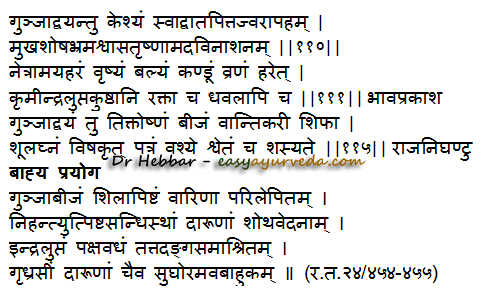
Abrus seed used as a simile:
The color of red gunja seed is used as a standard to explain normal colour of blood and also normal menstrual flow. – Charaka Sutrasthana 24/22
The color of skin lesions in Kakanaka Kushta – one among seven major types of skin disorders turns to red like abrus seeds. Reference: Charaka Chikitsa 7
Gunja – usage in weights
Gunja seeds are used as an important unit of measurement.
1 Gunja seed is considered as 125 mg of weight.
Ayurvedic medicines
Ayurvedic medicines with Gunja as ingredient:
Neelibhrungadi tailam – Herbal oil used for improving the quality of hair, to treat split hairs, premature graying and baldness
Sarivadi Vati – an Ayurvedic tablet used in treating hearing problems such as tinnitus, ear infection etc.
Gunja taila – For external application in skin disorders
Home Remedies of Gunja
By Dr MS Krishnamurthy BAMS, MD (Ayu), PhD
Few of the folklore and traditional uses of this drug are explained here below with their health benefits-
Petechial hemorrhage
Leaf paste application over the petechial hemorrhages and inflammation:
Fresh leaves are taken and fine paste is made.This is applied over the petechial lesions and inflamed area.This helps to reduce both the complaints.
Dysuria, hoarseness of voice
Milk boiled with leaves in dysuria and hoarseness of voice:
Dry or wet leaves are taken a fist full and cooked with 1 cups of milk and 2 cup of water till the amount is reduced to 1 cup.This is administered once daily.This is effective in dysuria as well as hoarseness of the voice.
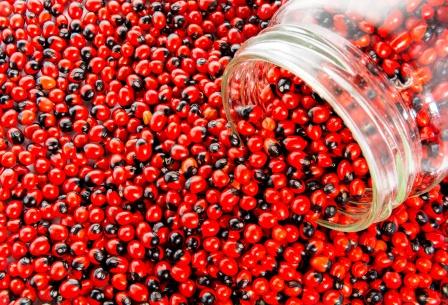
Cough, mouth ulcers
Chewing root powder for cough, throat irritation, mouth ulcers etc. :
The root powder (1-2 grams) is taken and mixed with honey. This is taken by licking. It is effective in cough, throat irritation, rhinitis, nausea and mouth ulcers.
As aphrodisiac
Medicated milk of root powder as sexual stimulant and aphrodisiac:
Regular administration of medicated milk of roots is a good tonic and rejuvenative. This is a good aphrodisiac also and invigorates the young adults.
Premature graying of hair, hairfall
Seed oil for premature grayness of the hair and hair fall:
10 grams of the seeds (powdered) are taken along with 100 ml of oil and soaked overnight. To this equal amount of leaf juice is added and oil is cooked in mild intensity of heat. This oil is filtered on complete evaporation of water content.
Read related: Oral Ayurvedic Medicines For Hair Loss And Hair Growth
This oil is used to apply to the scalp daily or once in two days. It has significant benefit over the greyness of the hair and hair fall.
Consult Dr Krishnamurthy MD (Ayu), PhD
Side effects
As per Drugs and Cosmetics Act, Gunja is a Schedule E1 classified herb. This means, the oral Ayurvedic medicines containing Gunja can only be taken under strict medical supervision.
If not purified properly or if used in excess dosage than prescribed, it can cause severe vomiting and diarrhea.
Unpurified seed powder used over wounds or direct contact with blood can also produce toxic effects.
Roots – if used in excess dose can cause vomiting
It is best to avoid Gunja or medicines containing it during pregnancy, lactation and in children below 5 years of age.
Interaction with medicines, supplements
Can this be used while taking Homeopathic medicine?
Yes. This product does not react with homeopathic medicine.
Can this medicine be continued while taking supplements like multivitamin tablets, Omega 3 fatty acids etc?
Yes. Generally, this product goes well with most dietary supplements. However, if you are taking more than one product per day, please consult your doctor for an opinion.
With western
medicines
Seek your
doctor’s advice if you are taking this product along with other western
(allopathic / modern) medicines. Some Ayurvedic herbs can interact with modern
medicine.
If both Ayurvedic and allopathic medicines are advised together, then it is
best to take Allopathic medicine first, wait for 30 minutes and then take the
Ayurvedic medicine.
Antidote
There is no specific antidote for abrin poisoning, and treatment is mainly supportive with intravenous fluids and correction of electrolyte abnormalities.
Research
Anticataractic and anti oxidant effects – The ethanolic seeds extract of Abrus precatorius protected the lens against calcium-induced oxidative damage which might be helpful in delaying the progression of cataract.
Taxonomy
Division – Magnoliophyta
Order – Fabales
Family – Fabaceae
Subfamily – Faboideae
Tribe – Abreae
Genus – Abrus
Species – Botanical name – Abrus precatorius
Vernacular names
Names in different languages:
English name- Abrus or Indian Licorice, Crab’s eye, John Crow Bead, Abrus seed, Jeriquity Vine, Wild liquorice, Rosary pea, Weather plant, Paternoster pea
Hindi name- Gamanchi, Gunchi, Gunja, Gaunchi, Rati
Kannada name – Gulaganji, Gulgunji
Telugu name- Guruvinda, Guruginia
Marathi name – Gunj, Gunja
Bengali name – Kunch, Koonch, Chunhali
Gujarati name – Chanoti, Gumchi, Chanothi
Tamil name- Gundumani
Malayalam name- Kunni, Gundumani
Farsi name – Chasmekharosh
Punjabi name – Mulati
Urdu name – Ghunchi
Kashmiri name – Shangir
Persian name – Gunchi, Chashami, Khurosa
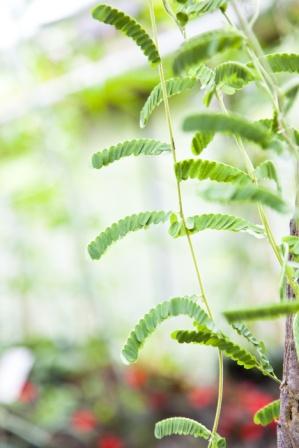
Sanskrit Synonyms
Chudamani, Kakanantika, Kakasahvaya, Bhillibhushani
Shikhandika, Sheetapaki, Ghughanta, Rati,
Krushnala – Seeds have black spot
Durmoha – Take of large quantity cause unconscious
Raktika, Tamra, Tamrika – coppery red coloured seeds
Bahuvirya – Gunja is very potent herb
Vanavasini – Grows wild
Kakachincha – Its fruit resembles chincha fruit
Shweta Gunja – white variety synonyms:
Shweta paki, Chudala, Kakapeelika, Durmaayaa, Chakripa, Chuda, Chakrashalya, Chirantika, Shweta Kambhoji, Bhiratika, Kakadani, Kakapeelu
Classical categorisation
Sushruta – Moola Visha
Kaiyadeva Nighantu – Oshadhi Varga
Dhanvantari Nighantu – Karaveeradi Varga
Bhavaprakasha – Guduchyadi Varga, Upavisha
Rajanighantu – Guduchyadi Varga
Morphology
Woody climber with compound leaves
Inflorescence – Raceme
Flower – Pale purple to yellowish in color
Fruit -Pods, 3 – 5 seeded
Seeds – Ovoid, glossy surfaced
Sthanika karma (Action on different system)
External application – External application of seed paste has Anti inflammatory, Analgesics action. It promotes hair growth and is indicated in non healing wounds. Oil prepared out if its leaf is indicated in neuromuscular disorders. decoction can be used for mouth gargling. Nasya with seed powder is indicated in headache.
Nervous System – Nerve stimulant, overdose can cause intoxication. strengthens the nervous system. Indicated in hemiplegia, neurological pain etc.
Digestive system – Leaf is unctuous in nature.
Respiratory system – Leaves and Roots are unctuous in nature and helps to expel out kapha dosha. Indicated in cough and hoarseness of voice.
Circulatory System – Cardiac stimulant
Excretory system –root and leaves increases urine output. indicated in dysuria
Reproductive System – For Aphrodisiac purposes milk prepared out of it can be given.. Seed can be taken as a contraceptive medicine. Root has abortifacient action.
Satmikarana – Seed is poisonous, low dose is indicated in general weakness.
Skin – Indicated in skin disorders
Tapakrama – indicated in fever










15 comments
Rakesh Sankhla
my name is Rakesh Sankhla and good page and article i’m interested.
Priya Gupta
Gunga la Chirantika he naaw aahe ka kiwa gunja aani chirantika wegle aahe ka.
Dr J V Hebbar MD(Ayu)Author
Chirantika is a synonym of gunja
DR.ANKEETA MUKHEDKAR
THANK YOU SIR UR INFO HELPED IN MY THESIS
Ujwalaa
Shangir is used for voice also? How to use
Dr J V Hebbar MD(Ayu)Author
Because it has some toxic effects, its usage needs direct consultation with an Ayurveda doctor.
jesan
application of paste of gunja on head is beneficial in hair loss?
Dr J V Hebbar MD(Ayu)Author
It is applied in cases of alopecia areata. It is not used for general hair loss treatment.
Manisha Dikshit
Can gunja beej or patra lepa used in yuvanpidica
Indira
Can gunja powder paste be used to regrow hair lost during premenopausal time. Or should nilibhringadi hair oil be used for this.
Dr J V Hebbar MD(Ayu)Author
Nilibhringadi hair oil is good
Foram rajgor
Gunja lap Is it safe to use externally in alopecia ?
Dr J V Hebbar MD(Ayu)Author
Lepa – local application, yes.
gopal
will it leave toxic effects if i soak the seeds in water for few days?
Dr J V Hebbar MD(Ayu)Author
No. That is not the standard way of detoxifying it. It could still be toxic.